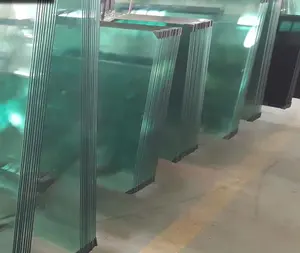(293180 products available)












































































































































































































































Tempered glass is also known as toughened glass. This is a safety glass that undergoes a process of heat treatment or chemical treatment to increase its strength. It is used when higher strength and safety are required. For example, car windows and shower doors are made of tempered glass.
The types of tempered glass include;
4mm tempered glass is widely used in homes and commercial buildings. Its applications include:
4mm tempered glass has several features that make it usable in all the applications discussed above. The features include:
Tempered glass, also known as toughened glass, is used in various industries and applications due to its strength, safety features, and thermal resistance. Here are some common usage scenarios:
Construction and Architecture
Tempered glass is used in building facades, windows, doors, skylights, and curtain walls. It provides structural integrity, safety, and aesthetic appeal in residential, commercial, and skyscraper buildings.
Automotive Industry
All vehicles, including cars, trucks, buses, and trains, use tempered glass on their side and rear windows. It offers impact resistance, safety, and clarity for drivers and passengers.
Interior Design and Furniture
Tempered glass is widely used in interior design and furniture applications. For example, glass tabletops, shelves, partitions, and decorative panels. It adds elegance and functionality to spaces while ensuring durability and safety.
Appliances and Electronics
Many household appliances and electronics incorporate tempered glass. Examples include oven doors, microwave doors, fireplace screens, television screens, and computer monitors. The glass provides protection, heat resistance, and clarity.
Bathroom and Shower Enclosures
Tempered glass is commonly used in shower enclosures, bathtub screens, and bathroom windows. It ensures privacy, water resistance, and durability in wet environments.
Railways and Public Transport
Trains, trams, subways, and other public transport vehicles use toughened glass for windows, doors, and passenger compartments. It guarantees passenger safety, visibility, and structural strength.
Marine Industry
Tempered glass is used in boats, ships, yachts, and submarines for windows, hatches, and observation points. It can withstand water pressure, impact, and harsh marine conditions.
Industrial Equipment and Machinery
Many industrial machines, tools, and equipment utilize tempered glass for protective covers, safety shields, and control panels. It offers visibility, impact resistance, and safety in industrial environments.
Security and Safety Applications
High-security areas, banks, jewelry stores, and government buildings use toughened glass for security purposes. Laminated tempered glass can resist forced entry, impact, and vandalism.
Sports and Recreational Facilities
Sports facilities, tennis courts, squash courts, gymnasiums, and swimming pools utilize tempered glass for walls, partitions, and windows. It ensures transparency, durability, and safety in sports environments.
When purchasing tempered glass for commercial or residential projects, it is important to consider several factors to ensure the right selection. Here are some tips to help you choose the right tempered glass:
Consider the Purpose
First, check the intended purpose or application of the tempered glass. Find out if it will be used for doors, windows, railings, shower enclosures, or any other applications. Each application has different tempered glass requirements.
Check the Thickness
Check the thickness of the tempered glass. Generally, tempered glass comes in different thicknesses. The thickness will vary depending on the application. For instance, thicker glass is mostly used in high-rise buildings or where structural support is required. On the other hand, thinner glass is suitable for applications like tabletops or interior partitions.
Check the Clarity and Color
It is important to check the clarity and color of the tempered glass. This is because clear and low iron glass offers high visibility. This is especially important in applications like curtain walls. On the other hand, tinted glass can be used for privacy or to reduce solar glare.
Edge Work
Edge work is an important aspect to consider when choosing tempered glass. The edge finish not only affects the appearance but also plays a role in safety. Polished edges are ideal for areas where people can walk near. This is because they reduce the risk of cuts. On the other hand, beveled edges add a decorative touch and enhance elegance.
Assess the Safety Features
Safety features enhance the safety of a tempered glass installation. For example, Non-Slippery surfaces reduce the risk of falls. Therefore, when purchasing tempered glass, assess the safety features. These include Anti-Scratch Coating, Safety Films, and Non-Slip Coating.
Consider the Aesthetics
Apart from the factors mentioned above, it is important to consider aesthetics. This ensures the tempered glass complements the design style and architecture. Factors such as Texture, Pattern, and Color contribute to the overall aesthetics.
Q1: How can one tell if a glass is tempered?
A1: One can tell that the glass is tempered by looking at the edges. The edges of tempered glass are usually polished and smooth. One can also tell through the scratch test where a simple scratch is made on the surface using a metal key. If the scratch shows, then the glass is not tempered, but if the scratch does not show, then the glass is tempered.
Q2: Can a tempered glass be cut and resized?
A2: No, it is not possible to resize tempered glass. The only way to obtain a size would be to provide it since the glass is only safe to handle during production. When resized, the glass may shatter into pieces.
Q3: What are the disadvantages of tempered glass?
A3: The main disadvantage of tempered glass is that it cannot be resized or cut after being manufactured. Additionally, it is more expensive than the regular glass. In case of breakage, tempered glass will shatter into tiny pieces and spread them around.